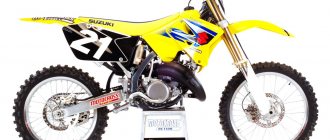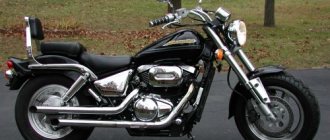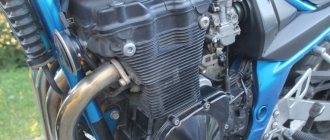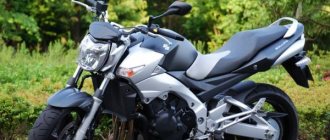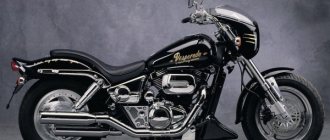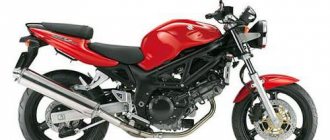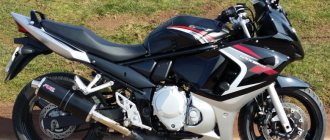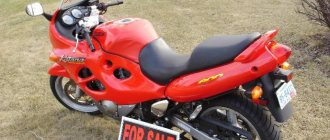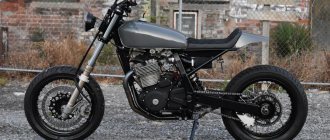Seeing the success that Kawasaki's line of Zizers (Kawasaki ZZR) received in the sports touring class, Suzuki representatives decided to keep up. Three years after the launch of competitors' models, in 1993 The Suzuki RF 400R model is introduced to the Japanese public. Just like the Zizers, in addition to the internal one, another version is put on the conveyor - with a 600 cc engine - for export.
The development turned out to be successful, the 400 cc bike sold no worse than its competitors, and later even managed to outperform them. Initially, the motorcycle was assembled on engines from Jixer (Suzuki GSX-R 400), later the line was divided into 2 directions. The second direction began to receive engines from the Suzuki GSF 400 Bandit .
Having the same parts as a more powerful model, the bike turned out to be practically indestructible. It was collected over 7 years. In 2000, the last Suzuki RF 400R rolled off the assembly line.
RF400 design
The design of the “four hundred” is based on a steel frame of a diagonal type.
For a road and at the same time sports bike, the developers decided to use steel. This solution:
- makes the structure heavier:
- makes it more durable;
- reduces the price of the final product.
For the latter, they also did not use any progressive, but untested solutions in the suspension.
The front wheel used a conventional telescopic fork (stay diameter 41 mm , stroke 120 mm ). Rear - one shock absorber on a pendulum basis (travel 125 mm ). From the settings we made adjustments for preload and rebound in the rear. The bikes of the first years also had the ability to adjust the fork preload, but a study of demand showed that this was not used and since 1995 it has been fixed , which again made it possible to reduce the price of the motorcycle.
Front fork.
Rear shock absorber.
The features of the bike include additional glove compartments in the front, a large windshield (like for sports), and a comfortable seating position.
Exterior
The model stands out from the crowd of competitors with characteristic “gills” on the sides for additional engine cooling. The decision turned out to be successful; the entire Suzuki RF line acquired it.
Front end
Low beam.
Headlight close-up.
Gills on plastic.
Steering wheel and mirrors.
- The large fender is tightly pressed to the 17-inch wheel . Above it is a small technological opening for air intake. The feathers behind the body kit are practically invisible. The last one is large, visually divided into 2 parts - the upper one with optics, glass mirrors, and the lower one, running along the motor. The dividing line is a design solution of the line, repeated on all older models.
- Here, at the level of this visual break, there are direction indicators . No frills, round buildings on their risers. Yellow in front, black in back. When trying to pack the bike, they are protected by a fault.
- The head optics are made in the form of one small square headlight . Interestingly, its size is directly proportional to the engine volume - at 600 cubic meters it is larger. There is practically no plastic underneath (before separation), above it the windshield continues, tilted back in a sporty manner. Due to the mounting, the mirrors are widely spaced, the viewing angle is good, and they do not protrude beyond the grips.
Dashboard
The release of 2 models at once had an impact here too. All blocks are the same, except that the marks on the speedometer are different.
The instrument panel is completely analogue, with four dial indicators and a block of signal lights.
This model has a speed of up to 190 km/h . In addition to the speedometer, there is a tachometer and an oil pressure indicator in front of the driver. The revolutions are marked up to 15x1000 , red from 13.5x1000 , the developers recommend 11x1000 .
All indicator lights are in a row, above the tachometer. The set is standard:
- neutral;
- turns;
- low fuel.
Back view
Rear optics.
Separate seats.
Fuel tank.
Trim on the tank.
- A motorcycle tightly sewn into plastic looks more like a sports bike . And there aren’t any tourist-specific features here either. As users note, the ergonomics of the model turned out to be unusual - neither classic nor sporty, but this does not affect the controls.
- The design of the rear optics is standard - the stop/marker is in the stem, there is a mudguard underneath, the turn indicators protrude beyond the bike using a metal strip on the mudguard. Here below is the number.
- There is no trunk , but there is space behind the second number, you can install it if you wish. Each passenger has his own saddle. The companion sits slightly higher than the driver. There is a handle for it and footrests are provided.
- The fuel tank looks huge , but holds only 17 liters , of which 3 liters is reserve, according to the standard. The head, as usual, is closed with a hatch, under which the lid itself is on the key. It is flat, the bag fits on the tank without any problems, but since it is located almost in front of the driver, holding the navigator in it can be inconvenient.
Review of the Suzuki RF400 (RF400RV) motorcycle
I bought it in the summer of 2009. Once you sit in the saddle, you immediately merge with the motorcycle, although for my 65 kg, the machine seemed a little heavy (almost 200 kg). But this impression is not correct. It all starts with movement. It moves off smoothly (well, if you don’t twist the trigger until it’s stupid), it will practically idle. I started and….!!! You won’t knock it down (again, unless you knock it down on purpose). The car is very well balanced. Reacts to the slightest rotation of the throttle. It flies out from under the F (well, again, it’s like twisting it). Quite a powerful device in its class. In turns, of course, the entry is difficult, you have to significantly reduce the speed and fall over. But it depends on skills. In principle, it is possible to put it on the footrest. Regarding the engine, it is very good. If not killed. Box is the same.
Everything is fine, but the problem is that the problem is always with the carbs, namely, after winter they are overfilled, repairing them costs from 500 to 1500 rubles, and you can also try to adjust the CO CH. there are screws on the exhaust manifold, they need to be unscrewed and adjusted with a gas analyzer on each carburetor, the price is only 400 rubles. for all 4 carbs. but otherwise the mot is excellent!!! just a bit heavy to begin with.
A motorcycle for beginner sport bikers. Unlike 400s of a purely sporting nature, it is very comfortable in terms of fit and smoothness of ride. Although the engine is very playful and allows you to pop, you have to rev it to the red zone! Those who liked this motorcycle should switch to the same modification but with a 900 cc engine.
Suzuki RF400 in my opinion is one of the best sport tourists in its class, very maneuverable despite its size and very good pick-up due to the red head and behaves very well at the bottom.
I had been choosing this motorcycle for almost a year, I was considering many options, but when I saw it, I sat on it and immediately decided that it was mine!))) I bought it not in the best condition, it was after a small accident, all the plastic was broken, I rode like that for the first year, and with the arrival of winter I started practicing first I made the chassis, changed all filters, oil spark plugs, changed the pads, installed a new gold chain, did 525 new sprockets, oil seals and boots on the forks. For the new season, I started doing the aesthetic side, I repainted it blue and since I deal with vinyls, I made a lot of carbon ones The frame itself was covered in white carbon, the bottom of the tail was covered in black, the front was also covered, and many other parts. I drove it for 3 seasons, no problems arose, only motul synchronized the carburetors every season and it served me faithfully) But after 3 years I wanted a more powerful device, as soon as I put it on the drive they immediately started calling, bought it in 3 hours) But how I sold it for a long time; I felt very sorry for it because I was very used to it (but I hope the new owner treats it with the same care as I do)
I’m very pleased with the bike, I’ve ridden a total of 8,500 km on it, I’ve ridden long distances - 600 km one way - all without problems.
It broke down once, the previous owner, Kulibin, inserted a male-female connector from a VAZ2109 into the wiring, as a result, over time, the connector melted and just while driving, all my electrics were turned off and the bike died... Thanks to the biker guys of Moscow and the Motositezen movement, they stopped themselves, They helped me figure out what was wrong, fixed everything and escorted me home (60 km one way)... I didn’t expect this in these days.
I sold it after 2 seasons, now I’m looking at the VFR800.
The bike is good, I rode it for one season, then it changed a little to a liter. It really doesn’t start well in the cold, and it doesn’t drive well at 92, it’s better to use 98, otherwise it will stall. In general, a lot has been written about it on the internet, its wheelbase is long and it’s a bit heavy for 400.
Specifications
Cylinder block.
An exhaust manifold.
Filler plug.
Cooling radiator.
Dividing the model into two directions allowed the bikes of the new wave to get good traction at the bottom, but this did not affect the overall picture. The Dzhikser engine had 4 strokes , 4-cylinders with an in-line arrangement and could not jump higher than its head:
- Working volume - 398 cm3.
- Power - 53 hp
- Maximum torque - 37.0 Nm.
- Number of valves - 16 (4 per cylinder).
- Cooling is liquid.
- Fuel supply - Mikuni carburetor.
- Ignition is transistorized.
- Start - electric starter.
Users note that the bike is quite picky about fuel quality. AI-92 accepts, but goes reluctantly.
Stock muffler.
Direct flow option.
Transmission and clutch
The motorcycle was equipped with a 6-speed gearbox. According to users, fast dynamics are not for this box. Gear ratios are spread across the entire rev range. It works well, switches clearly. True, neutral is sometimes difficult to catch.
- Multi-plate clutch , oil bath, power transmission - cable.
- The main drive is chain .
The chain is covered with a protective shield on top.
Brakes
Disc hydraulics are supported by 2-piston calipers. The only difference is the diameter and number of disks.
Front brakes.
Rear brake.
Front: brakes
- number of disks - 2;
- diameter - 290 mm;
- support - 2-piston.
Rear brakes
- number of disks - 1;
- diameter - 240 mm;
- support - 2-piston.
No options provided.
Features of the Suzuki SV400 model
Thanks to its compactness and low weight, the SV400S is fast and maneuverable .
The motorcycle has excellent dynamics (accelerates up to 140 km/h without visible effort) and handling, and behaves stably on the road.
The design allows the driver to sit as comfortably as possible. Responsive and informative suspensions with a wide range of settings cope equally well with both asphalt and dirt surfaces.
This is also facilitated by effective brakes; the 16-liter tank provides a sufficient power reserve.
The proposed model range of the Ural Solo motorcycle is presented in several options.
This model will be a real find for collectors of Soviet motorcycles - the shape, base, style and chassis correspond to that time.
Driving performance
The maximum speed announced by a company representative is 190 km/h . The bike has become one of the few where the maximum mark on the speedometer corresponds to the declared data.
Despite the opinion of users about poor dynamics, the motorcycle reaches 100 km/h when accelerating from a standstill in 4.9 seconds .
Fuel consumption
The developers describe fuel consumption in a rather funny way. If you drive (it is not clear where) at a city speed of 60 km/h , then the consumption will be a record 2.5 liters .
In the city (at the same speed) - already 6.5 liters .
The route is up to 5 l .
Approximate cost
On the secondary market, this bike can be bought for about 80,000 - 200,000 rubles.
New motorcycles are not officially supplied to Russia ; they can only be purchased by order.
In Russia, the model from Suzuki - SV 400 C has many fans.
Despite the fact that the debut took place more than 15 years ago, the popularity of the model still remains high.
Both the “Japanese” version (SV400) and the “export version” (SV650) are in demand.
The company’s successful attempt to create a road motorcycle is the Yamaha Tricker 250, with the possibility of using it in a “trial”.
Review of a model that attracts attention:
Dimensions and weight
When viewed from the side, the motorcycle strongly resembles a sports bike, which in fact it is half of it.
Despite the smaller engine volume, the RF400 is able to compete with its older brothers and, which is understandable, by designing 2 bikes in parallel, the designers did not think twice and the 400 received the same parts as the 600, and then the 900.
- The dry weight of the motorcycle is 186 kg .
- Equipped, filled with all fluids - 204 kg .
Bike dimensions:
- in length - 2,116 mm ;
- width - 721 mm ;
- in height - 1,181 mm .
Seat height - 779 mm .
Wheelbase - 1,432 mm .
Ground clearance - 116 mm .
For whom is it intended?
The RF 400 successfully combines modern appearance with the comfort of a classic road bike.
As they write in some publications, the average Japanese is our 18-year-old boy who will choose exactly 400 cubes.
And the low position of the motorcycle above the ground will allow a biker of any height and build to ride comfortably.
Modifications
The Suzuki RF 400VR model was produced in red and blue colors.
In 1996, the model was divided into 2 directions. variable valve control - also comes from Bandit . In translation - control of valve timing. This made it possible to increase traction at low levels and slightly unload the engine.
The development also received several cosmetic changes:
- stainless steel muffler;
- red brake discs;
- VC badges on tank and rear
Model code name RF 400VR .
Suzuki RF line
All models in the line were practically no different from each other in appearance, except for the stickers with the cubic capacity of the moto. Although on the 900 there were additional “gills” just in front of the driver’s seat.
In 1993, two models were put on the production line at the same time.
- Suzuki RF 400.
- Suzuki RF 600.
The third went into production a year after the start of production - in 1994.
- Suzuki RF 900.
Competitors
The direct competitor is the Kawasaki ZZR 400, a well-known model from another flagship of the motorcycle industry.
Since the line was planned to push Kawasaki's ZZR development into the market, it was expected that the 400s and then the 600s would compete with each other.
Several differences between the model and Kawasaki:
- production closes in 2007 (versus 2000 for RF 400);
- aluminum frame (steel for RF);
- carburetors of our own design;
- 4-piston brake calipers;
- The diameter of the front discs is larger;
- The rear suspension has a full range of adjustments.
Prices for Suzuki RF 400
Approximate prices are as follows: a 1995-1996 model in average technical condition and with minor plastic problems costs about 85-100 thousand rubles, more recent motorcycles in well-maintained condition will cost 125 thousand and more.
Conclusion: this motorcycle is suitable for both the city and long-distance trips. Good brakes and smoother operation of the gearbox compared to the Zizer can tip the scales in favor of this model. There are no problems with spare parts; you can always find all the necessary components and assemblies on the market. We recommend it to all fans of sports tourism.
Advantages
Even a quick review of the Suzuki RF 400 shows that the bike is capable of competing with younger and more modern models.
- Ergonomics.
- Wind protection.
- Good brakes.
- Balancing, weight distribution.
- Moderate quiet riding without wheelies or stops.
Many people note that to enter a turn the motorcycle has to be pushed, but on the other hand, it is noted that the oncoming truck is practically not felt.

